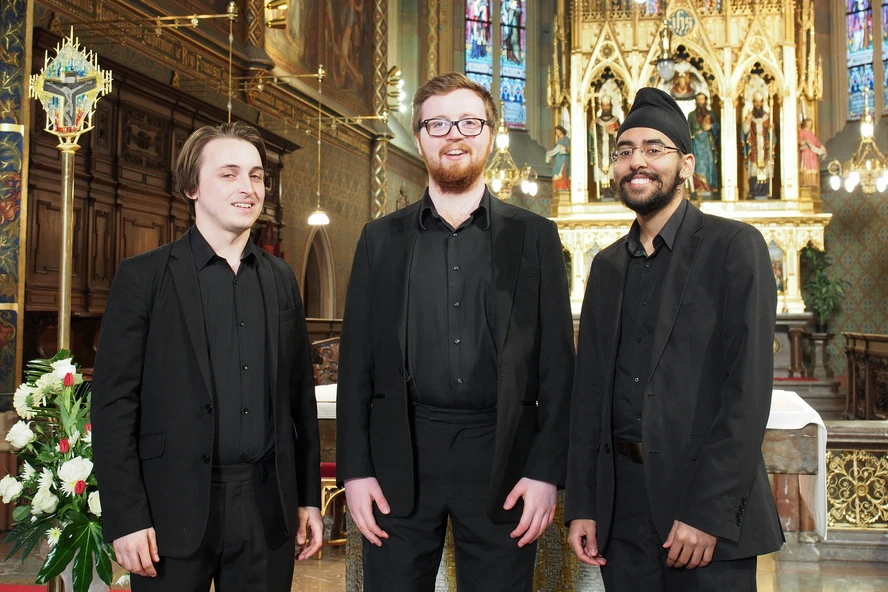Paříž byla na konci dvanáctého a začátku třináctého století vzkvétajícím střediskem uměleckých a intelektuálních aktivit. Díky výstavbě nové katedrály, jejíž první kameny byly položeny v šedesátých letech dvanáctého století, a založení Pařížské univerzity si město vytvořilo mezinárodní renomé coby vzdělávací centrum v oboru teologie a svobodných umění. Z mnohdy vzdálených částí Evropy se do ní sjížděli studenti a učenci za vyhlídkou intelektuálního rozvoje.
[block background=“#e5e5e5″]For English version of the article please see below.[/block]
V tomto kontextu, při katedrále Notre-Dame a univerzitě, a také díky vzkvétající produkci rukopisných knih, vykrystalizovala pařížská hudba, konkrétně ta vícehlasá (polyfonní), v jednu z nejvlivnějších a nejrozšířenějších kolekcí skladeb ve středověké Evropě. Právě v této hudbě můžeme nalézt třeba počátky nových skladatelských technik. Ty se výrazně lišily od dosavadního způsobu zpěvu, který podléhal požadavkům konkrétních příležitostí k jeho provozování. Hudebníci zde začali poprvé experimentovat s nejrůznějšími skladatelskými postupy a technikami organizace hudebního materiálu, především s kontrapunktem, a zkoumali, jak zpívat melodie chorálu v konkrétním metru podle systému rytmických vzorců. Rovněž rozvíjeli způsoby, jak metrum vyjádřit písemně za pomoci nových způsobů notace.
„Zacházení s minulostí“ v hudbě Paříže 13. století
Pařížský repertoár tvoří tři hlavní žánry – organum, konduktus a moteto. Organa jsou polyfonními zhudebněními chorálu a byla určena k obohacení mší a oficia při významných církevních svátcích. Dva hlavní způsoby, jakými bývají strukturovány, se nazývají purum (čisté) a diskant. Organum purum je charakteristické dlouhými tóny chorálu v nejspodnějším hlase a zdobnějšími hlasy vrchními ve volném rytmu, oproti tomu v diskantu všechny hlasy podléhají rytmické organizaci. V některých případech jsou diskantové části organa v rukopisech zapsány zvlášť coby hudební útvary známé jako klausuly. Zatímco tyto útvary plnily jasnou liturgickou funkci, u jiných polyfonních žánrů pěstovaných v Paříži není liturgický účel tak zřejmý. Některé kondukty a moteta jsou založeny na zcela světských textech, což svědčí o tom, že tato hudba byla provozována mimo zdi katedrály stejně tak často jako uvnitř. Rozlišování mezi duchovní a světskou hudbou se tak stává z důvodu častého užívání stejného existujícího hudebního materiálu napříč skladbami, a dokonce napříč žánry, dosti složitým. Například v motetu můžeme pohromadě nalézt citaci chorálu ve spodním hlase, vrchní hlas tvořící základ klausuly, text v lidovém jazyce a třeba i melodii refrénu vycházející z lidové tradice; to vše svědčí o šíři vzájemných melodických i textových vlivů napříč různými oblastmi pařížského hudebního života.
V Paříži se také významně posunul vztah k historii. V této jedinečné kulturní konfiguraci sehrál způsob vnímání minulosti zásadní roli, nejen co se týče proměny způsobu, jak uchovávat hudební repertoár, ale ovlivnil i estetické hodnoty, které stály v pozadí vzniku nové hudby. Nový pohled na historii podnítil šíření hudební praxe daleko za hranice Paříže, podněcoval nové způsoby psaní hudby a historické povědomí o hudebních stylech zcela jinak než v předchozích stoletích (zde máme na mysli např. polyfonii z Winchesteru z počátku jedenáctého století nebo akvitánský repertoár na konci jedenáctého a ve dvanáctém století).
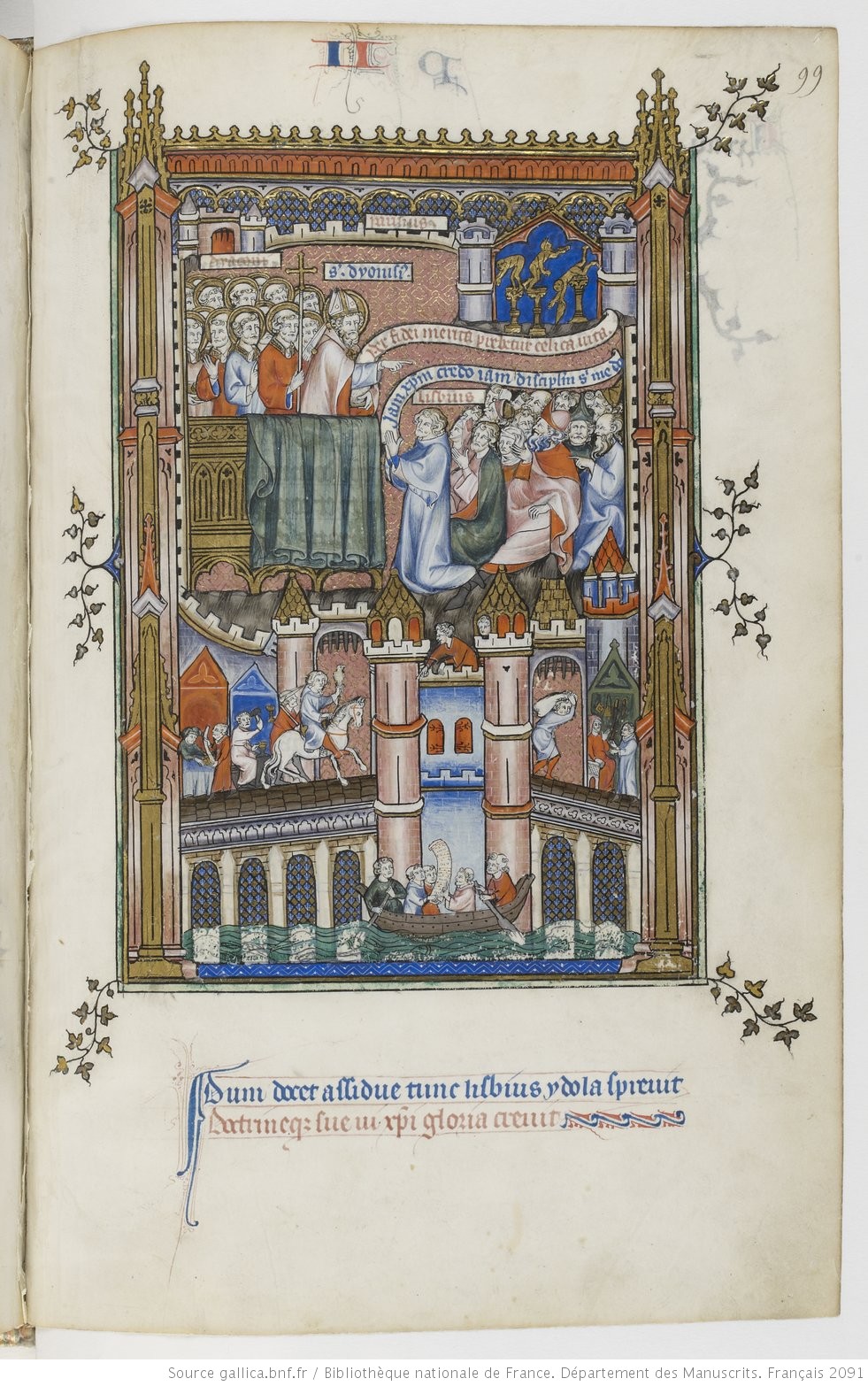
Výzkum týmu badatelů z Cambridge, který probíhá v rámci evropského projektu Sound Memories („Zvukové vzpomínky“) a je financovaný programem Humanities in the European Research [HERA], se snaží pochopit, jak pařížští hudebníci dvanáctého a třináctého století pohlíželi na svou hudební minulost. Projekt chce zodpovědět dvě hlavní otázky. Zaprvé, jak hudebníci této doby psali polyfonní skladby – jak při komponování postupovali a jak pracovali se starším hudebním materiálem? A zadruhé, jak je tento repertoár zachován v rukopisech – jak je notován a uspořádán a co lze říci o povaze těchto rukopisů?
Klausula – první příklad, kdy „umění“ stojí nad pravidly
K zodpovězení těchto otázek nás může nasměrovat jeden z charakteristických žánrů liturgické polyfonní hudby Paříže třináctého století: klausula. Klausula, založená na části chorálu (obvykle graduale nebo alleluia pro mši a responsorium k oficiu), je úryvek diskantové polyfonie, psaný nejtypičtěji pro dva hlasy. Chorál zní v nejspodnějším hlase – „tenoru“, a je často uspořádán do opakujících se rytmických vzorců, zatímco vrchní hlas prozkoumává svůj vlastní motivický materiál v konkrétním metru jako odpověď chorálu. Dochované rukopisy s polyfonním repertoárem obsahují stovky klausul, buď shromážděných zvlášť v samostatných částech knihy, nebo vepsaných do rozsáhlejších organ (viz organum purum). Například v rukopisu Wolfenbüttel, Herzog August Bibliothek, cod. Guelf. 628 Helmstadiensis (známém jako W1) se nachází ve dvou složkách 102 klausul, v páté složce rukopisu „F“ (Florence, Biblioteca Laurenziana, Pluteus 29.1) dokonce celých 462. Je zajímavé, že tyto rukopisy nejen zaznamenávají polyfonní zhudebnění mnoha různých částí chorálu, ale zároveň dokumentují rozmanité způsoby jeho zpěvu. Poskytují svědectví o tom, jak se množství hudebníků pokoušelo nejrůznějšími způsoby ze starého materiálu vytvořit novou skladbu, i s jakým entusiasmem testovali konkrétní techniky a kompoziční postupy, aby zjistili, jak daleko s nimi lze zajít.
Vezměme si například dvě klausuly založené na výňatku z chorálu, konkrétně melismatu „tanquam“ z responsoria Descendit de caelis, který se zpíval v katedrále Notre-Dame na Štědrý den o nešporách. Obě zhudebnění zacházejí s melodií chorálu stejně, tedy uspořádávají ji do rytmického vzorce, který se skládá ze tří stejně dlouhých not. Nicméně přestože je rytmický vzorec v obou klausulách stejný, způsoby, jakými vrchní hlasy na tento podklad reagují, se od sebe značně liší. V první ukázce je zhudebnění založeno na struktuře antifony, kde se tenor střídá s vrchním hlasem a pohrávají si spolu v sekvenčních postupech. Druhé zhudebnění je naopak až extrémním příkladem toho, jak daleko lze zajít v práci s jedním konkrétním motivem; odhodlání zachovat kontinuitu vybraného rytmického vzorce zde často zcela zastíní otázku, zda hlas vůbec konsonuje s tenorem.
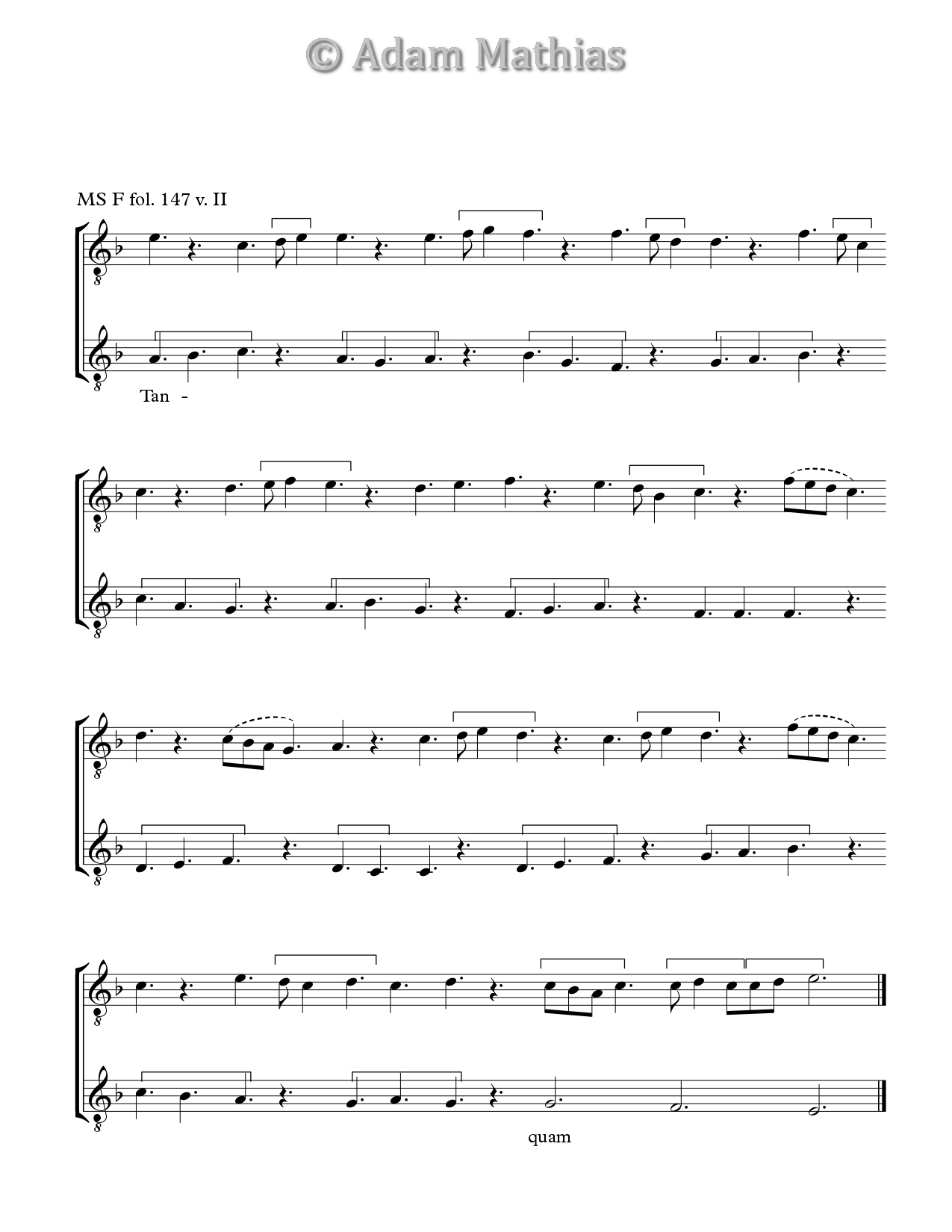
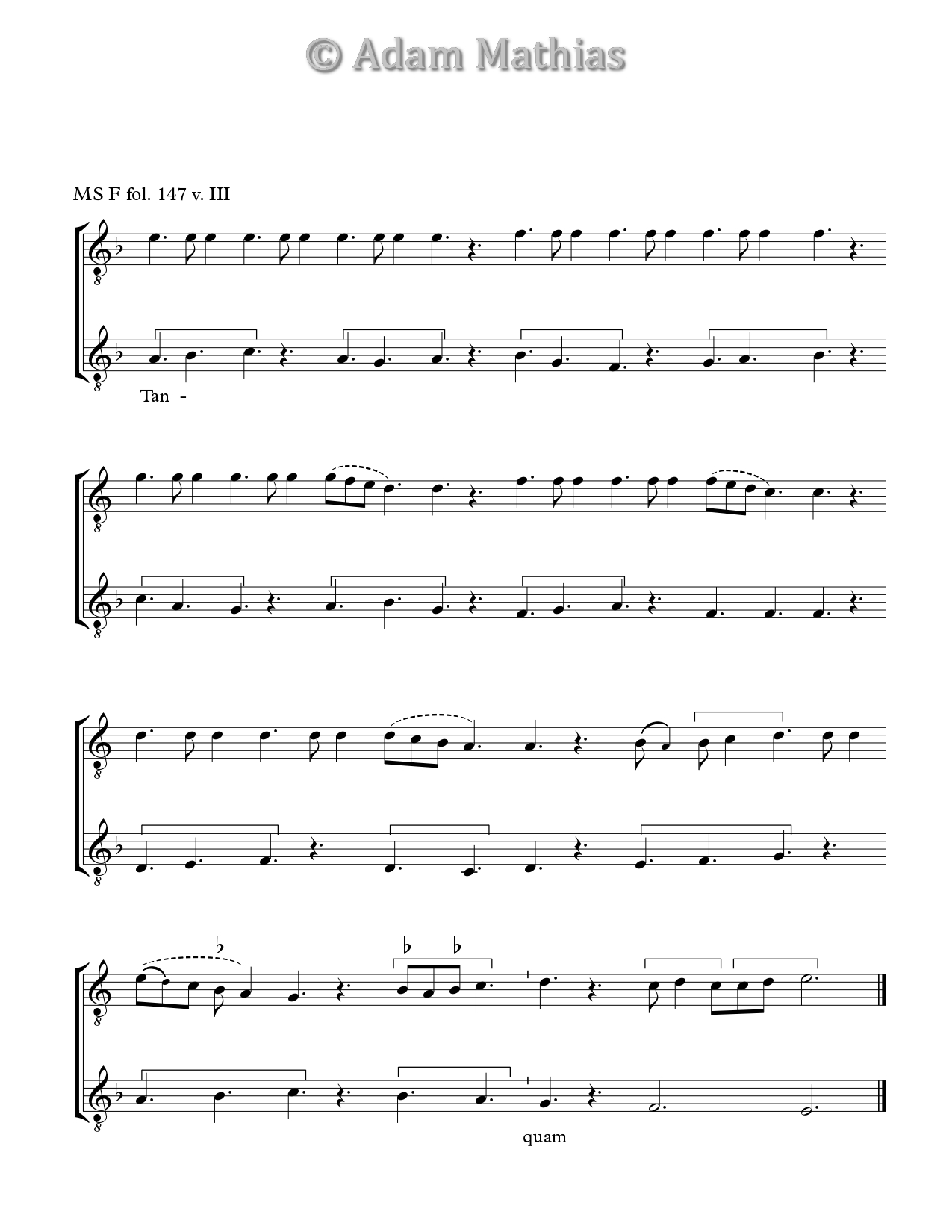 Vztah, jaký mají klausuly k hudební minulosti – jak pracují se starším chorálním materiálem nebo jak jsou řazeny v dochovaných rukopisech – je složitější, než by se na první pohled zdálo. Například hudební základy klausul – tedy části chorálu – se, zdá se, často liší od způsobu, jakým se chorál v jednohlasé praxi zpíval. Zatímco notované knihy liturgického zpěvu z dvanáctého a třináctého století chorál zpravidla zaznamenávají až na drobné odchylky velmi podobně, v jeho používání v tenoru coby základu polyfonních klausul lze nalézt značné rozdíly. To naznačuje, že hudebníci využívající liturgické melodie šli daleko za rámec jejich pouhé reprodukce. Spíše je schválně pozměňovali a různě s nimi manipulovali, aby ve skladbě naplnili nějaký hudební koncept. Toto zjištění je velmi důležité, neboť poukazuje na změnu ve vnímání chorálu; věrná citace se najednou stala méně důležitou než čistě umělecké ambice – právě ty ve výsledku určovaly, jak bude s chorálem v polyfonii nakládáno.
Vztah, jaký mají klausuly k hudební minulosti – jak pracují se starším chorálním materiálem nebo jak jsou řazeny v dochovaných rukopisech – je složitější, než by se na první pohled zdálo. Například hudební základy klausul – tedy části chorálu – se, zdá se, často liší od způsobu, jakým se chorál v jednohlasé praxi zpíval. Zatímco notované knihy liturgického zpěvu z dvanáctého a třináctého století chorál zpravidla zaznamenávají až na drobné odchylky velmi podobně, v jeho používání v tenoru coby základu polyfonních klausul lze nalézt značné rozdíly. To naznačuje, že hudebníci využívající liturgické melodie šli daleko za rámec jejich pouhé reprodukce. Spíše je schválně pozměňovali a různě s nimi manipulovali, aby ve skladbě naplnili nějaký hudební koncept. Toto zjištění je velmi důležité, neboť poukazuje na změnu ve vnímání chorálu; věrná citace se najednou stala méně důležitou než čistě umělecké ambice – právě ty ve výsledku určovaly, jak bude s chorálem v polyfonii nakládáno.
Knihy, ve kterých jsou klausuly zapsány, tedy rukopisy, jejichž obsah tvoří převážně polyfonní hudba, jsou v Paříži třináctého století také novým úkazem. Rukopisy W1 a F jsou oba rozsáhlými přehledovými antologiemi, na jejichž stránkách je shromážděno mnoho různých typů hudby. Ovšem jejich fyzická podoba, obsah, velikost a kvalita vyhotovení prozrazují, že každá vznikla s jiným záměrem, v důsledku čehož pak každá prezentuje tento hudební repertoár trochu jinak. Ve zkratce, W1 je daleko zjevněji knihou určenou pro zpěváky k přímému použití. F je oproti tomu o dost rozsáhlejší a obsáhlejší než ostatní sbírky, je nádherně vyhotovený a bohatě iluminovaný. Je třeba jej proto považovat za smělý archivářský projekt, vyhotovený za účelem sesbírat a fyzicky zaznamenat vše, co by mohlo reprezentovat pařížskou hudební praxi předchozích desetiletí. Lze tedy říci, že srovnání těchto dvou knih odhaluje dva kontrastní přístupy ke sběru a shromažďování hudebního materiálu. A to nás může vést k vytvoření mnohem nuancovanějšího pohledu na různé způsoby zobrazování hudební minulosti. Můžeme tak sledovat, jak uvědomělé využívání hudební minulosti v tomto repertoáru formovalo nejen skladatelskou praxi, ale i způsoby, jakými byly skladby v knihách zapsány; to vše díky intenzívnímu akademickému ruchu a ekonomické prosperitě Paříže dvanáctého a třináctého století.
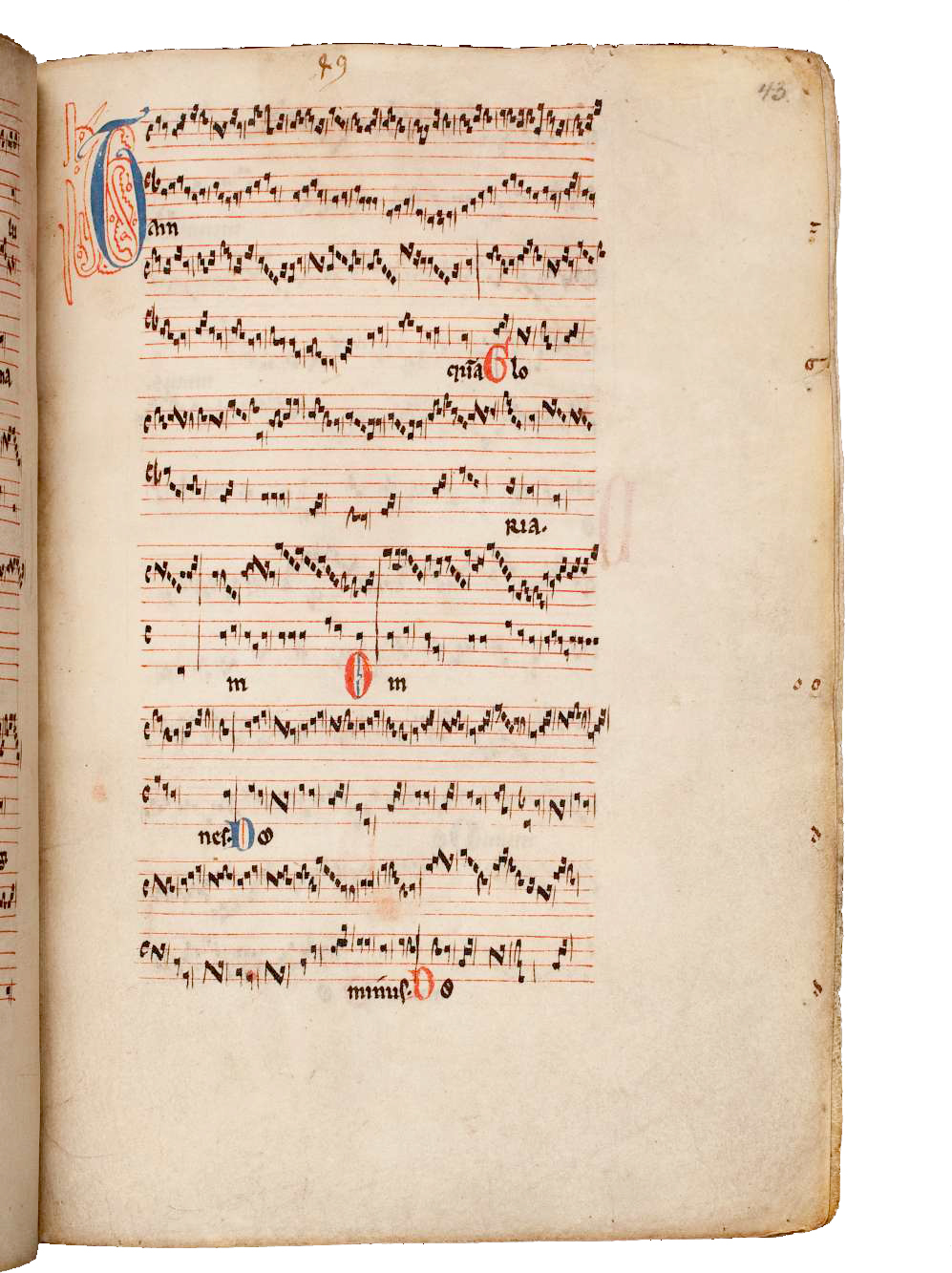
Anonymous III
Badatelský tým z Cambridge přistupuje ke zkoumání pařížské hudby třináctého století ještě dalším, dosti odlišným způsobem. Se svým partnerem z projektu Sound Memories, souborem Anonymous III založeným v roce 2017 (Gopal Kambo, Michael Bell, Stephen Matthews) se snaží úžeji propojit otázky pramenící z výzkumu s provozováním této hudby, která je jinak k slyšení jen vzácně. Zpěváci z Anonymous III v mnoha ohledech fungují jako konzultanti výzkumu, zajišťují hudební ukázky, zpívají na workshopech a konferencích a propagují daný repertoár na mnoha koncertních pódiích napříč Evropou. Nejpodstatnější ovšem je, že přes úvahy nad tím, jak tuto hudbu zpívat, a skrze řešení konkrétních hudebních problémů se můžeme dozvědět daleko více o tom, jak tato hudba vůbec vznikla – jak byla komponována a proč se po středověké Evropě tak rychle proslavila. Zkoumáním způsobů, jakými se tato hudba vyvinula z ústní tradice, a nasloucháním způsobům, jakými jsou ve skladbách používány různé skladatelské techniky – ať již s nimi různí tvůrci zacházejí podobně či každý po svém – máme šanci lépe porozumět kompozičním postupům při tvorbě tohoto repertoáru a tím pádem i okolnostem jeho vzniku.
Muzikologové a zpěváci z Cambridge tak začínají načrtávat obraz často spletitých vztahů středověkých hudebníků k hudební minulosti. Ten by mohl sloužit jako odrazový můstek pro zkoumání historického povědomí a způsobů zacházení s hudebním dědictvím i v dalších repertoárových oblastech, kterými se týmy projektu Sound Memories věnují. Zvýšená míra uvědomování si „hudební minulosti“ skutečně výrazně ovlivňovala jak hudební praxi třináctého století, tak způsoby, jakými se tehdejší aktéři pokoušeli svědectví o této praxi uchovat v písemné podobě. Je možné, že porozumění těmto procesům nám může pomoci i v uvažování nad naším vlastním pohledem na hudební historii; jak se hudba podílela, a stále podílí, na vytváření naší společné kulturní paměti a identity.
Přeložila Barbora Vacková
[block background=“#e5e5e5″]Tento seriál vzniká v rámci evropského projektu HERA Sound Memories: The Musical Past in Late-Medieval and Early-Modern Europe, který řeší mezinárodní tým muzikologů pod vedením Prof. Karla Kügleho (Utrecht) v pěti akademických institucích (Univerzita Utrecht, Univerzita Cambridge, Univerzita Curych, Univerzita Karlova Praha, Polská akademie věd Varšava).
Adam Mathias je studentem doktorského studia na univerzitě v Cambridge. Pod vedením prof. Susan Rankin se věnuje hudební kultuře Paříže ve 13. století a otázkám historického povědomí v hudbě.
Více informací (včetně audio- a videozáznamů) najdete na webových stránkách projektu Sound Memories.[/block]
Vážení čtenáři, vzhledem k mezinárodnímu složení badatelského týmu mimořádně uveřejňujeme českou i anglickou variantu textu.
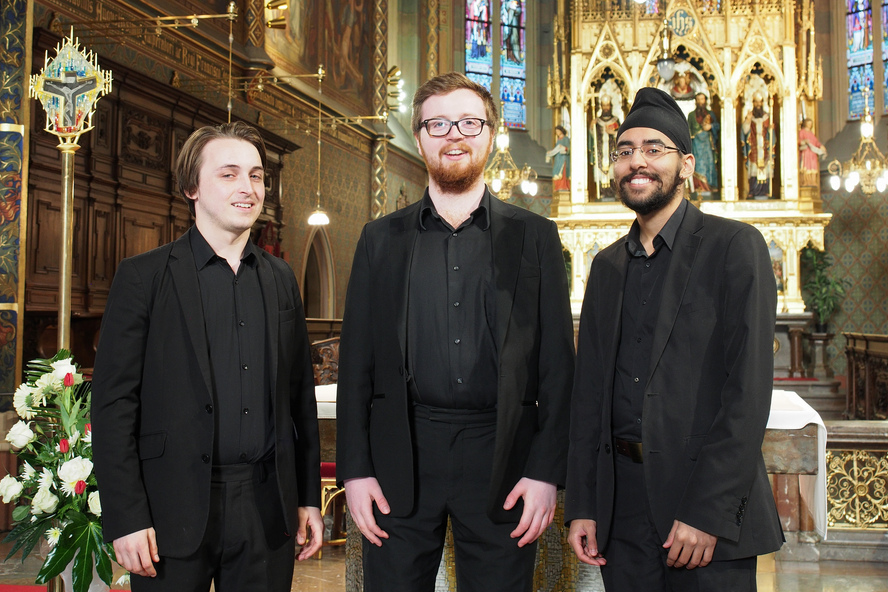
Memory and Tradition within the European Music Culture of the Late Middle Ages and the Early Modern Times (a series)
In the late twelfth and early thirteenth centuries, Paris was a flourishing centre of artistic and intellectual activity. With the construction of a new cathedral (work for which had begun by the 1160s) and the emergence of the University of Paris, the city developed an international reputation as a pedagogical centre in theology and the liberal arts – from distant parts of Europe, students and scholars converged upon the city, drawn by the opportunity to learn from an intellectual milieu.
In this context – around the Cathedral of Notre-Dame, the university, and a burgeoning manuscript trade – Parisian music, and in particular, polyphonic music, emerged as some of the most influential and widely disseminated musical repertories in medieval Europe. In this music, for example, we can discern the beginnings of new techniques of musical composition – in contrast to ways of singing practised in performance and subject to the requirements of those specific moments. Here, for the first time, musicians sought to experiment with all sorts of strategies and techniques for organising their material, above all, ‘counterpoint’, exploring ways of singing their chant melodies in measured time according to a system of patterned rhythms. They also developed ways of representing this measured sound in writing according to new notational frameworks.
“Uses of the Past” in the Music of Thirteenth-Century Paris
The Parisian repertory consists primarily of three genres: organum, conductus, and motet. Organa are polyphonic settings of liturgical chant; music to enrich the celebrations of the Mass and Office on the significant feasts of the church year. The two main textures prevailing within organa settings are purum and discant; purum is characterised by long held notes of the chant in the lowest voice and more florid upper voices above, while, in contrast, discant organises all the voices in rhythmic measure. Sometimes, these discant sections of an organa were also preserved separately within manuscripts – as pieces known as clausulae. But while these pieces have a clear function within the liturgy, other genres of polyphonic music cultivated in Paris have a less explicit liturgical purpose – some conductus and motets are based upon distinctly secular texts – illustrating that this music was practised outside the walls of the cathedral as much as it was inside it. Indeed, such distinctions between sacred and secular often become difficult in this repertory because of the considerable reuse of existing music material between pieces and even across genres. In a motet, for instance, we may find together a chant melody in the lowest voice of the piece, upper voice material that also forms the basis of a clausula, a vernacular text, and perhaps too, a refrain melody from vernacular lyric tradition – a sign of the extensive web of musical and textual interactions across Parisian musical practice.
Attitudes towards musical history also shifted significantly in this Parisian context. In this unique cultural situation, perceptions of the musical past became crucial not only in transforming documentary practices that preserve this repertory, but they also influenced the aesthetic values that informed the creation of new music. This new historical outlook fostered the wide dissemination of musical practices outside of Paris, new forms of music writing, and a historical consciousness about musical styles in ways qualitatively distinct from previous centuries, for instance, as compared to the polyphonic music of early-eleventh century Winchester, or even the Aquitanian repertory of the late eleventh and twelfth centuries.

The research of the Cambridge team within the collaborative ‘Sound Memories’ project, funded by Humanities in the European Research Area [HERA], seeks to investigate the ways twelfth- and thirteenth-century Parisian musicians viewed their musical past. The project seeks to answer two questions in particular: how did musicians of this period create pieces of polyphony – what kinds of compositional behaviours underpin this process, and how do they build upon pre-existent musical materials? Second, how are these repertories preserved within manuscripts – how are they notated, ordered, organised; and what can be said about the nature of such manuscripts?
“Clausulae”
One specific genre of liturgical polyphonic music cultivated in thirteenth-century Paris – the clausula – offers a route into these questions. Based upon a portion of chant, normally a gradual, or alleluia for the Mass, or a responsory for the Office, a clausula is a passage of discant polyphony most commonly for two voices. The chant appears in the lowest voice of the setting – the “tenor” – and is often organised into recurring rhythmic patterns while the upper voice explores its own motivic material in measured rhythm, as a response to this chant. Surviving manuscripts containing this polyphonic repertory preserve hundreds of clausulae – either gathered separately in their own portion of the book or copied into larger pieces of organa. The manuscript Wolfenbüttel, Herzog August Bibliothek, cod. Guelf. 628 Helmstadiensis (commonly known as “W1”), for example, preserves 102 clausulae across two fascicles and manuscript “F” (Florence, Biblioteca Laurenziana, Pluteus 29.1), a markedly large collection, contains 462 settings in its fifth fascicle. Significantly, such manuscripts not only record polyphonic settings of many different chant melodies; they also document multiple ways of singing single portions of chant, bearing witness to a musical practice in which musicians sought out many different ways of making a piece of music based upon the same material, as well as to the enthusiasm with which they tried out specific musical techniques and compositional strategies to see how far they could be pushed.
Take, for instance, two clausulae based upon a portion of chant – the melisma ‘tanquam’ from the responsory ‘Descendit de caelis’ to be sung at First Vespers on Christmas Day at the Cathedral of Notre-Dame. Both settings handle their version of the chant melody in the same way, organising it into a rhythmic pattern three notes in length. But though the rhythmic pattern of the chant is consistent across the two clausulae, the way in which the upper voice responds to this underlying framework is considerably different. The first is based upon an antiphonal texture, alternating between tenor and upper voice, and exploring a number of sequential figures. The other setting provides a rather extreme example of how far one specific motif can be exploited within a setting – with the continuation of an established motivic pattern often superseding considerations of consonance with the tenor.

 The relationships clausulae repertories have to a musical past – in the ways they make use of older chant materials, or in the ways they have been ordered and organised into surviving manuscripts – are more complex than we might initially presume. For instance, the musical foundations of clausulae – passages of plainchant – appear to frequently differ from monophonic practices of singing chant melodies. While notated Parisian books of liturgical chant from the twelfth and thirteenth centuries are generally very consistent in their transmission of chant materials (though some variation can be observed), we find considerable diversity in the versions of the melodies used as polyphonic tenors of clausula settings. This suggests that, in this polyphonic context, musicians did not simply reproduce liturgical melodies. Rather, they were able to deliberately alter and manipulate them in order to realise particular musical designs within a piece. This is significant because it highlights a change in how musicians used the chant: apparently the faithful rendition of a melody was less important than purely artistic motivations which came to influence the way the chant is to be rendered in polyphony.
The relationships clausulae repertories have to a musical past – in the ways they make use of older chant materials, or in the ways they have been ordered and organised into surviving manuscripts – are more complex than we might initially presume. For instance, the musical foundations of clausulae – passages of plainchant – appear to frequently differ from monophonic practices of singing chant melodies. While notated Parisian books of liturgical chant from the twelfth and thirteenth centuries are generally very consistent in their transmission of chant materials (though some variation can be observed), we find considerable diversity in the versions of the melodies used as polyphonic tenors of clausula settings. This suggests that, in this polyphonic context, musicians did not simply reproduce liturgical melodies. Rather, they were able to deliberately alter and manipulate them in order to realise particular musical designs within a piece. This is significant because it highlights a change in how musicians used the chant: apparently the faithful rendition of a melody was less important than purely artistic motivations which came to influence the way the chant is to be rendered in polyphony.
The books these clausulae are copied into, manuscripts whose main contents are polyphonic music, are also a new phenomenon in thirteenth-century Paris. The manuscripts W1 and F are both large anthology books – compendium volumes – that collect and compile many types of music among their pages. But the physical characteristics of each book, their contents, their size, their quality, suggest different intentions of their makers; in turn, they present very different representations of this musical repertory. Put plainly, W1 is much more obviously a book for the direct use of musicians. F, however, is much larger and more comprehensive than any of the other collections, beautifully made, and illustrated with pictures. It is to be considered a huge archival endeavour, made in order to garner and physically record everything which might represent Parisian musical practice of the previous decades. A comparison of the two books can be seen to reveal contrasting attitudes to collecting and assembling musical material, encouraging us to develop a more nuanced view of the different portrayals of a musical past represented by the manuscripts. At once, therefore, we can see how self-conscious uses of the musical past not only come to shape the compositional practices in operation within this repertory, but also the way pieces are to be recorded in books – something made possible by the newly intense scholarly exchanges and economic prosperity of Paris in the late twelfth and thirteenth centuries.

Anonymous III
An altogether different way the Cambridge team is approaching research into thirteenth-century Parisian music is through musical performance. With an Associate Partner of the Sound Memories project established in 2017 by the name “Anonymous III” (Gopal Kambo, Michael Bell, Stephen Matthews) the Cambridge team has sought to align questions arising from research more closely with performance of this rarely heard music. In many ways, Anonymous III have acted as a sounding board for research, having provided musical examples, performed in workshops, sung at conferences, and put on concerts of this music in many venues across Europe. But on a more fundamental level, by thinking about how this music is to be sung, and the arising issues of musical performance, we might be able to learn more about how this music was conceived of in the first place: how it was created, and how it came to be so widely known in medieval Europe. As a result, by examining the ways this music developed out of an oral practice, and by listening to the ways compositional techniques are worked out within a piece, that are shared across settings, and those that are used differently across the repertory, we hope to come closer to understanding the compositional behaviours in operation within this repertory, and consequently, closer to understanding the processes that led to its creation.
The Cambridge team’s work begins to paint a picture of the often complex relationships medieval musicians had with their musical past – serving as a springboard for the types of historical awareness and manipulation of the past that underpin the repertories studied by other SoundMe teams. Indeed, this heightened consciousness of a ‘musical past’ is something that shapes thirteenth-century musical practices and the ways they wanted to preserve these practices in writing in numerous forms. Perhaps too, it offers a way for us to think about our own views of music history; how music has been – and continues to be – involved in the negotiation of cultural memory and identity.
[block background=“#e5e5e5″]This series has been published as part of the European project HERA Sound Memories: The Musical Past in Late Medieval and Early Modern Europe, undertaken by an international team of musicologists led by Prof. Karl Kügle (Utrecht) in five academic institutions (Utrecht University, the University of Cambridge, the University of Zurich, the Charles University in Prague, and the Polish Academy of Sciences in Warsaw).
Adam Mathias is a doctoral student at the University of Cambridge. Under the supervision of Professor Susan Rankin, he focuses on musical culture in thirteenth-century Paris and questions of historical consciousness in music.
More information (including audio and video recordings) see on Sound Memories project website.[/block]
This project has received funding from the H2020-EU.3.6 – SOCIETAL CHALLENGES – Europe in a Changing World – Inclusive, Innovative and Reflective Societies under grant agreement no. 649307. The project Sound Memories: The Musical Past in Late-Medieval and Early-Modern Europe is financially supported by the HERA Joint Research Programme (www.heranet.info) which is co-funded by AHRC, AKA, PT-DLR, CAS, CNR, DASTI, ETAG, FCT, FNR, F.R.S.-FNRS, FWF, FWO, HAZU, IRC, LMT, MIZS, MINECO, NCN, NOW, RANNÍS, RCN, SNF, VIAA, VR and The European Community, SOCIETAL CHALLENGES – Europe in a Changing World – Inclusive, Innovative and Reflective Societies under grant agreement no. 649307.
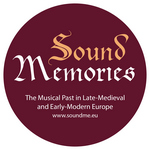 |
 |
 |
